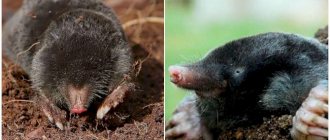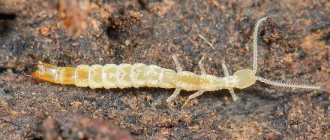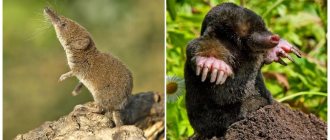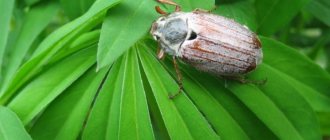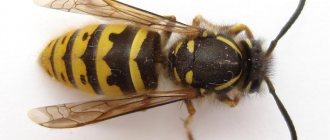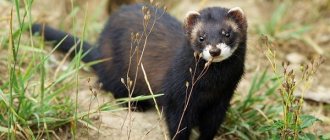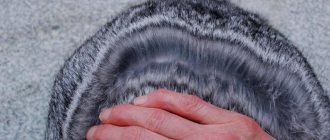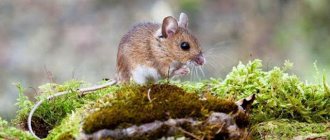A mole is an insectivorous mammal that spends almost its entire life underground. These little animals are silent and invisible, but at the same time they live almost everywhere. People often don't notice unusual animals because they rarely come to the surface.
Nature has endowed moles with unique abilities that allow the animals to live comfortably underground.
general characteristics
In the natural environment, there are several varieties of moles. The smallest representative of the species is the Sichuan shrew mole, its body length rarely exceeds 6–8 cm, its tail is from 5 to 6.5 cm, and the body weight of a mature individual is only 10–15 g. The largest mole is the Ussuri moger, length the body of a mature individual is from 20 cm, and the weight can reach up to 300 g. All moles, without exception, have characteristic features that help them survive underground.
Moles have a short, bar-shaped body, rounded at the sides.
The neck is not pronounced and seems to be a continuation of the body. If you look at the mole from above, it seems that the head grows straight from the shoulders. The shape of the head is cone-shaped, wider at the back of the head with a well-defined narrowing towards the nose.
The animals' ears are vestigial without an auricle. The location of the ear canals is determined by the presence of a skin ridge. In some varieties, the kalik is almost invisible under a layer of wool. The nose of moles is narrow and protrudes strongly above the lower lip; it is mobile and sensitive. The nostrils are wide, located on the sides, but directed forward.
Usually the mole's nose is not covered with hairs, with the exception of long, sensitive whiskers.
Unlike other varieties, the nose of the star-nosed mole ends not with an ordinary lobe, but with unique star-shaped skin outgrowths. They are soft, sensitive and similar to earthworms, the number of outgrowths is about 22 pieces.
Underground life has left its mark on animals. The moles' eyes have lost their intended purpose and are almost completely hidden under the skin. In some species, such as Caucasian moles, the eyeballs can only be seen on an x-ray. In others, the size of the eyes does not exceed the diameter of a poppy seed. Sometimes the eyes are equipped with a regular eyelid, which protects them from dust and soil. But some varieties have small slits in the skin opposite the eyes.
Elena
Ask a Question
Question to the expert
How do moles navigate underground?
Moles cannot see, but they have a well-developed sense of smell and hearing. They are able to smell or hear prey under a thick layer of earth. Animals also navigate thanks to sensitive vibrissae on the nose and tail.
Moles are quite toothy creatures, depending on the species they have maybe 34 to 44 well-developed, sharp teeth. They help hold nimble prey and chew food.
Subterranean mammals communicate with each other using various sounds. They may squeak, hiss or squeal.
Moles have strong and well-developed forelimbs with five-toed paws.
Each toe has a thick, blunt claw designed for digging. The claw is slightly curved outward, and on the inside there is a small depression that allows you to better grip the ground when digging tunnels.
There are no membranes between the fingers, but the hands are wide, spade-shaped and with the palms turned outward.
Under the ground, moles can move forward with their heads or tails. Moreover, the speed in both cases is the same. The fur on the animal's body is located in such a way that it does not interfere with movement. The wool easily bends in the desired direction.
The hind limbs are long, thin and somewhat reminiscent of rat paws in structure. The hind legs have claws, but they are much smaller than the front ones. The tail of moles is quite long, from 2 to 10 cm, its size depends on the type of animal.
Moles are very good swimmers. During a flood, small animals are able to swim across even a strong stream or a small river.
The entire body of animals is covered with soft, dense fur.
The wool grows perpendicularly and has special constrictions in the core. This allows the hairs to bend in any direction and makes it easier for the animal to move underground. Surprisingly, the fur of moles practically does not get dirty; fine debris and dust do not penetrate deeply, but settle at the very ends of the hairs. Therefore, it is enough for the mole to shake itself to clear the soil from its coat.
The color of the coat depends on the type of animal and its habitat. In the natural environment you can find black, dark brown, gray, dark red moles with different shades of fur.
Molting among underground inhabitants occurs 3–4 times a year.
Moles can shed both in the off-season and in the summer. This feature is due to the fact that animal fur quickly wears off from contact with rough surfaces. That is, in fact, the mole constantly renews its fur coat and only in winter does molting not have a pronounced character. Areas of skin where there is no hair become dense and darken. The remaining hairs are quickly wiped off, and new ones grow in their place.
The first molt of moles begins from April to June. Usually the females molt first, followed by the males. The second molt occurs already in July, in adults the spring coat changes to summer, and in young animals the baby coat comes off and an “adult” coat grows. The third autumn moult begins almost without interval; it is well expressed and occurs very quickly. The thin summer coat changes to a thick winter coat. During this period, animal fur is considered the most beautiful; it shines, shimmers, and becomes velvety to the touch.
Question to the expert
Is it possible to have a mole as a pet?
Moles cannot live in captivity. It is important to consider that the animal spends most of its life underground. Therefore, only professionals can provide an unusual pet with comfortable conditions.
Lifestyle of moles
The mole spends most of its time underground. Most individuals are active both during the day and at night. During the day they have several periods of activity lasting 3-4 hours, and during breaks the animals rest in the nest.
Typically, moles lead a sedentary lifestyle, but in hot and dry weather, some individuals leave their usual areas and move 1-1.5 km away from them, going to rivers to drink.
Die-hard loners
Most species lead a solitary lifestyle. Each animal has its own individual area. Moles zealously defend their entire territory, or at least a significant part of it. This applies not only to males, but also to females, who are especially aggressive towards members of their own sex during the breeding season. Females and males meet only for a short time to procreate. After mating has occurred, the male disappears from the life of the female, taking no part either in arranging the nest for the offspring or in their upbringing.
Population densities vary by species and habitat. In spring, males significantly increase the size of their territories. In a mole population, there are usually from 5 to 30 individuals per 1 hectare.
Although neighboring animals each live in their own tunnel system, their territories still overlap to some extent. However, they try to avoid encounters with each other and feed in non-adjacent parts of their areas.
When a mole dies, the neighbors quickly notice its absence, and the most efficient one seizes the vacated territory. Sometimes a plot may be divided between neighbors.
Moles communicate their presence and ownership of a specific area using scent marks. Both males and females have preputial glands that produce a strong-smelling secretion. It accumulates in the fur on the animal’s belly, and when moving, it spreads along the bottom of the tunnels. In the absence of such a smell, the territory is quickly captured.
What do moles eat?
Most of the mole's diet consists of invertebrates. About 90% of food is obtained from tunnels (feeding passages). The animals eat everything that is available in a certain place, but if there is a choice, they prefer earthworms, beetle larvae and slugs.
In October and November, the common mole stores supplies of worms immobilized by a bite next to the nest. They found reserves of worms and insect larvae in his possession exceeding 2 kg!
Molehills
Moles spend most of their time underground, but when developing a new area they often come to the surface. The passages of one animal occupy a huge area and are of two types. Residential passages run at a depth of 6–90 cm, have a diameter of about 5 cm and are used to move the animal from the nest to feeding areas, watering places, etc. Moves of the second type are used to search for food. They are laid close to the surface of the earth in a layer where earthworms and soil insects are most common and the soil is minimally dense. The network of passages covers large areas. Traces of hunting can be seen on the surface of the earth in the form of long soil ridges formed by swollen arches of passages. Such traces remain when a mole digs too close to the surface of the soil and the arch of the passage does not withstand the pressure of the animal.
When digging new tunnels, the mole rests with its hind limbs and digs with its front limbs, which alternately cut into the soil and move to the side and back. Then the animal compacts the soil with its powerful head, pressing it into the walls of the passage. When constructing holes at a depth of more than 10 cm, the mole can no longer lift the arch with its head and is forced to throw the excavated soil to the surface. Thanks to this, the presence of a residential passage can be detected by characteristic heaps of discarded soil - molehills. They can be 15-25 cm high and reach one meter in diameter. Usually molehills are located in small groups.
Molehills are the most obvious sign of the presence of these animals, and often the only thing people see.
The appearance of offspring
The mating season for moles is short. Breeding time varies depending on the geographical latitude of the habitat.
Moles usually produce only one litter per year. Pregnancy, depending on the species, lasts from 30 days (in the common mole) to 42 days (in the Eastern American mole).
The young are born in the nest, and a brood usually contains 2 to 7 young. Babies are born naked, but after 2 weeks they are completely covered with fur, and at the age of 22 days they open their eyes. For about a month, small moles feed on their mother's milk, and at the age of about 35 days they leave their mother's nest and go in search of unoccupied territory. At this time, many young animals die from the teeth of predators or under the wheels of cars.
Enemies in nature
In nature, moles have few enemies: due to the specific smell, predators practically do not eat these animals. Foxes, cats and dogs catch them more out of “sporting” interest. And only badgers can eat them.
However, pets to some extent control the number of moles and rodents near humans. It has been noticed that in private houses and cottages where there are pets - cats and dogs, there are practically no moles in the areas.
Habitat
Moles live almost all over the world, with the exception of those areas where the ground is unsuitable for digging and cold areas where the soil freezes to great depths. Representatives of the underground world can be found in Europe and Asia. On the Asian part of the mainland, animals are found in the Caucasus, Turkey, China, Mongolia and Indochina. The only exceptions are the southern regions. On the American continents, mole populations are found in southeastern Canada, Mexico, and almost all central and eastern regions.
Mole populations are found only in areas suitable for their existence.
Animals prefer loose soils. They never settle in wetlands. The main condition is the availability of food supply; the more food, the more animals can gather in one area. Populations usually inhabit clearings, forest edges, non-water meadows and agricultural fields.
Living environment and lifestyle
Well, we won’t be original here. Everyone has seen mole holes on the ground, and therefore it is easy to conclude that the mole’s habitat is soil. If we see such small mounds of earth in a meadow, there is no doubt that the burrower lives in the depths of the lawn.
Animals prefer to live in moist, loose soil. Such soil is easier to dig, and, of course, this digger always tries to find such an underground environment convenient for living.
However, in the absence of this, the animal does not lose heart, and is quite capable of living in a denser soil environment, it’s just that in this case the length of the tunnels it digs is not so great.
If the soil is what it needs, a blind mole is able to dig through fairly long underground passages, dotting the surface of the earth with molehills, that is, holes for oxygen to enter the burrow system, as well as for throwing away excess building material (soil).
Mole burrows can extend for hundreds of meters, and such underground passages dug by moles are complex labyrinths looped into a single system.
What do they eat?
The diet of most varieties consists of earthworms, slugs, snails, insects and larvae that hide underground or in dead leaves. But starfish, in addition to their usual food, can feed on small fish, shellfish and other underwater creatures. And mogers supplement their menu with butterflies and caterpillars. In addition, many varieties include plant foods in their diet.
On average, moles feed 5 to 6 times a day.
After each meal, the animals curl up into a ball and fall asleep. Sleep lasts from 3 to 4 hours, the mole spends this time digesting food. In one meal, the animal eats about 20–30 g of worms and insects; per day, the amount of animals eaten can exceed 90–100 g. In the summer, the amount of food eaten increases, as the heat speeds up metabolism.
Moles have a high metabolism, so they must eat a new portion every 14–17 hours. If the animal does not find food, it may die of hunger.
After the mole catches the worm, it eats it whole or tears it into small pieces. But before eating, the animal always squeezes the earth out of the worm’s body.
1: Moles can destroy a vegetable garden
An impeccable myth that makes you think about how to drive moles out of your area. But no animal will ever eat greens: they are carnivores, they like larvae, woodlice, beetles, mice, rats and other pests. Moles are able to clear an area of mole crickets - this is really a big plus.
As for damage to the roots of trees and bushes, the mole will try to get around these “thickets”. But if there is no other way, then it will tear up the roots, but only to get out into free space.
Lifestyle and character traits
The mole's entire life is spent underground. Animals very rarely leave their tunnels and come to the surface.
A massive emergence of moles can only be observed during the breeding season or spring flood.
Lifestyle
Moles dig long but shallow passages, rotating around their axis and spreading their paws. If the move is shallow, then a small roller appears above the surface, and all the earth is compacted. But when constructing permanent tunnels at a depth of 15 cm, the mole throws excess soil to the surface.
A pile of earth around the entrance to the labyrinth can reach a height of 50 to 80 cm and is called a molehill.
Elena
Ask a Question
Question to the expert
Do moles hibernate?
Moles do not hibernate, but in winter they practically do not appear on the surface. They stock up and eat from their pantries all winter. But animals can make tunnels under snow and fallen leaves in search of additional food.
Character and habits
Moles are famous for their thriftiness. Animals build pantries in their tunnels and store food in them in winter and summer. Most animals have several storage rooms, in case they have to leave their main home.
Moles do not dig a hole every time they go in search of food. Usually the worms themselves crawl into dug tunnels based on the musky smell and heat that the underground animal gives off.
Underground inhabitants lead a solitary lifestyle and unite in pairs only during the mating season. Moles are very quarrelsome and jealously guard their territories from outsiders. They mark the boundaries of their possessions with an odorous secretion that accumulates on the fur in the abdomen area.
Types of moles, photos and names.
Below is a brief description of several types of moles.
- The common mole, also known as the European mole (lat. Talpa europaea ) belongs to the genus of common moles. The body length of the animal reaches 12-16 cm, weight 55-90 g, tail length 2-4 cm. The animal's eyes are small, with narrow slits, without movable eyelids and eyelashes. The fur is black with a lighter shade underneath. The color of moles varies from black-gray and black-brown to completely black. Adults have darker fur than juveniles. The offspring appears once a year. European moles live in the forest-meadow zone of Europe, as well as in the European part of Russia, the Caucasus, the Urals and Western Siberia.
Photo credit: Valery91Thunder, CC-BY-SA
- The blind mole (small mole) (lat. Talpa caeca ) is a representative of the genus of ordinary moles. One of the smallest moles. The length of its body is 8-12 cm, the length of the tail is 2-3 cm. The mole weighs up to 30 g. The animal’s eyes are located under the skin. The basis of its diet is insects and their larvae. It consumes earthworms less frequently than other moles. Reproduction begins in early spring, when there is still snow. Blind moles live in the mountainous regions of the Caucasus, Turkey, and Northern Iran.
Photo credit: Daniele Seglie, CC BY-NC
- The long-tailed mole (lat. Scaptonyx fusicaudus ) represents the monotypic genus Scaptonyx of the same name. A small animal with a body length of 7.2-9 cm and a weight of up to 12 g. The length of the tail reaches 4.5 cm. The fur is sparse and hard. Long-tailed moles live in the coniferous highland forests of Northern Myanmar, Southern China and Northern Vietnam. The passages are dug shallow.
Photo credit: Huet, Public Domain
- Caucasian mole (lat. Talpa caucasica ) belongs to the genus of ordinary moles. The sizes for representatives of the genus are average: body length 10-14 cm, weight - 40-95 g, tail length 2.5 - 3.2 cm. Females are smaller than males. The color of the fur changes from bright black after molting to brown over time. The mole's eyes are subcutaneous. It makes shallow moves: from 5 to 20 cm in depth, but it can go deep up to 1 meter. The diet is based on earthworms, less often insects and larvae. It bears offspring once a year. The Caucasian mole lives in the southern and central parts of the Ciscaucasia, Transcaucasia and the Greater Caucasus, as well as on the Black Sea coast of Turkey.
- Siberian mole (Altai mole) (lat. Talpa altaica ) is a species from the genus of common moles. The distribution range of the animal is Western Siberia, western Eastern Siberia, southern Transbaikalia, northwestern Mongolia. Inhabits forested areas, except swamps, and river valleys in permafrost areas. In appearance, the animal is similar to the European mole, but is larger in size. Males have a body length from 13.5 to 19.5 cm and a weight of 75-225 g. The body length of females varies from 128 to 171 mm, weight ranges from 70-145 g. The tail is short, from 17 to 36 mm in length. The mole's eyes have a movable eyelid. Individuals living in Altai have a darker color: dark brown and black. Among the inhabitants of the northern plains, black takes on a smoky hue. There are also albinos, yellow, red and spotted individuals. The Siberian mole eats earthworms and insect larvae. The animal differs from many other species of moles in that its pregnancy lasts 9 months: mating occurs in the summer, but the embryos freeze and begin to develop only in the spring. Young animals appear from late April to late May.
- The Japanese shrew mole ( urotrichus talpoides) is the only species of the genus of the same name. Named for its resemblance to a mole and a shrew at the same time. The body size of the animal is small: 8-10 cm. The length of the hair-covered tail reaches 3 cm, with a tassel at the tip. The thick and soft fur of these moles is not velvety. It has a dark brown or black color with a metallic sheen. The animal moves both along long passages located shallowly and along the very surface of the earth. The Japanese shrew mole climbs bushes and trees to a height of 2-4 m. In winter, it sometimes roosts in empty bird nests and birdhouses. It breeds once a year. This species of mole inhabits the treeless slopes of mountains and volcanoes from the base to 2000 m above sea level on the southern islands of Japan.
Taken from: nyandfulworld.blog84.fc2.com
- Japanese mogera (middle mogera) (lat. Mogera wogura ) belongs to the genus Mogera. The size of the animal reaches 12-15.6 cm. The tail is short: 2-2.4 cm. Body weight is 95-210 g. On the back and sides, the mogera’s fur is black or dark, brown and gray, the peritoneum is lighter. Sometimes there are buffy spots on the chest, around the front legs and at the bottom of the abdomen. Basically, the Japanese mogera feeds on insect larvae: earthworms occupy the second place in its diet. Japanese mogers live in the southwest of the Japanese archipelago: in the southern part of the island of Honshu, the islands of Shikoku, Kyushu, some islands of the Inland Sea of Japan, the Korea Strait, the East China and the Sea of Japan. On the mainland, these moles inhabit some eastern regions of China, the Korean Peninsula, and in Russia - the south of Primorsky Krai. The grasslands and agricultural lands on which Japanese mogers live can be located at altitudes of up to 1000 m above sea level. These moles build two-level passages: at a depth of 50-70 cm and 1-1.5 m.
Taken from the site: alcedoatthishin1.blog99.fc2.com
- Star-nosed (star-nosed) (lat. Condylura cristata ) is a mole from the genus Condylura. Its body length is 18.9-21.1 cm. The tail is scaly, up to 8 cm in length, covered with sparse hairs. In winter it thickens to the diameter of a pencil. The star-nosed mole is similar to ordinary moles in the structure of its front legs, the absence of ears, small eyes (which, by the way, are not hidden under the skin) and thick, even black or dark brown fur. A distinctive feature that predetermined the name of this species is the presence of a star-shaped stigma, consisting of 22 leathery, fleshy processes. With the help of these tentacles, the mole searches for food. All of them are movable, except for the two in the middle at the top, which are directed forward and do not bend. The star-nosed mole swims and dives well not only in summer, but also in winter under ice. In water it eats small aquatic inhabitants and fish, on land it eats earthworms and mollusks. In addition to the aquatic and underground, the starfish also leads a terrestrial lifestyle, moving on the ground or snow. On the surface, these animals can even build nests, placing them in rotten stumps or deposits of leaves. Sometimes muskrats settle in the walls of huts. The animals prefer moist soils. They settle in meadows and forests, along the banks of streams and near swamps. Star-nosed bats live in the southeastern regions of Canada and in the southeastern states of the United States from southern Labrador to North Carolina.
Photo by: Martin Minarik
Reproduction and raising of offspring
In most cases, the timing and duration of the mating season depend on the species and habitat.
Moles, depending on the species, reach maturity a few months after birth or a year later.
Mating season
On average, the mating season begins at the end of March, but some individuals mate underground while there is still snow on the surface. Therefore, the timing of the birth of cubs can vary significantly. In addition, young females go looking for a mate later than adults.
During the mating season, moles leave their underground shelters. Females usually do not go far from their tunnels and wait for a male to appear in their territory. Males, on the contrary, actively move in search of a partner and are guided by smells and sounds.
Interesting Facts
Moles are unique and amazing creatures in their own way. But it is not recommended to have an unusual animal at home. Because not every professional can create conditions for a comfortable life.
Many interesting facts are known about moles, however, they are considered an incompletely studied species. This is due to their specific habitat.
Interesting Facts:
- Moles, like all underground inhabitants, are very sensitive to vibration. Their behavior can predict disasters such as earthquakes, volcanic eruptions and landslides. In general, everything that is connected with the movement of the earth's layers.
- Molehill soil is an excellent source of fertile soil for garden beds. It does not need to be sifted, it is airy and loose.
- Some Danish archaeological scientists use moles in excavations. Small and very hardworking creatures push to the surface everything that prevents them from digging a tunnel. Including archaeological finds.
- The word "mole" is used to describe secret agents in intelligence organizations. People of this profession, like moles, must have the ability to quietly infiltrate any structure.
- Dirt and dust do not stick to mole fur. It is enough for the animal to shake itself off to get rid of small debris.
- In the cartoon “Thumbelina,” the old mole took his bride to the storerooms with a large supply of food. In real life, moles are indeed famous for their thriftiness. Their tunnels are used for food storage.
- Mole passages lie at shallow depths, but can be from 100 to 200 meters in length, which is several hundred times greater than the size of the animal itself.
- There is a bone in the external genitalia of males.
- Moles do not hibernate, but since it is very difficult to find food in cold weather, they make impressive reserves.
- Contrary to myths and rumors, all moles have eyes. It’s just that in some animals they are located under the skin and are visible only on x-rays. In most cases, the small eyes are hidden behind small slits in the skin or eyelid.
- Like all small animals, moles have an increased metabolism. Therefore, animals must eat almost constantly. An adult animal can eat an amount of food equal to its own weight per day.
- The animals do not live in captivity and are not tamed. At one time they tried to breed them to obtain soft skins, but the idea quickly failed.
- In the USSR, moles were hunted for their skins. Every year the population decreased by several million individuals. Currently, mole hunting is prohibited.
- In loose soil, a mole can dig a meter-long tunnel in 3–5 minutes.
- According to statistics, moles destroy about 1% of crops worldwide. Basically, they do not eat plants, but their active underground activity leads to damage to roots and death of crops.
- A mole's mouth has more teeth than a human's. Depending on the variety, the number of teeth can be from 34 to 44 pieces.
- Moles molt 3-4 times a year.
- In addition to the main food pantries, each mole has an additional warehouse in case something happens to the main one.
- Moles see practically nothing. But animals have very sensitive hearing and a well-developed sense of smell.
- Some moles are excellent swimmers and can even swim across a stormy stream. And such a species as the starfish is capable of diving and preying on underwater inhabitants.
- On occasion, moles may dine on a small mammal or bird.
- Moles' fur grows straight up without tilting. But each hair has a constriction in the central part, this allows it to bend in different directions.
Harm and benefit to humans
The predator does not pose a danger to humans, but a summer cottage can be seriously damaged. The role of the animal is twofold. Rodents seriously damage the lawn by creating their labyrinths under the area. They choose these places because there are a huge number of earthworms under the root system of the grass. Eating invertebrates also disrupts soil fertility. Earthworms are useful creatures for summer cottages. Their destruction by rodents leads to the appearance of a large number of pests.
The animal is also capable of destroying the root systems of cultivated plants, which is why planted vegetable and fruit crops in the country begin to die.
But if there are only a few insectivores, then they have their own benefits. Constant loosening of the earth fills the soil with useful elements. In addition, the underground creature fights one of the main pests for the garden and vegetable garden - the mole cricket. Insect is one of the mole's favorite dishes. The mole cricket is quite filling for a predator and is not poisonous.
Another benefit to people is animal skins. Rodent fur is highly valued in the fur market. Their skins are very warm and durable.
